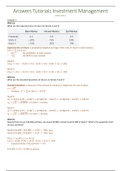Samenvatting
Summary Investment Management; Tutorial Answers ()
- Vak
- Instelling
- Boek
Solutions to all the questions covered in the tutorials of the course; Investment Management. Useful to check your own work or to look something up when you don't know the answer, with extensive explanations
[Meer zien]






